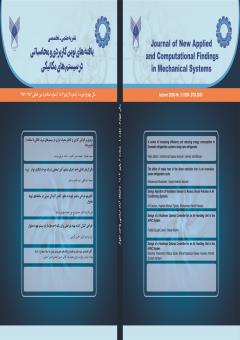بررسی عددی زاویه قرارگیری کویل در کندانسینگ یونیت چیلرهای هوا خنک
محورهای موضوعی : یافته های نوین کاربردی و محاسباتی در سیستم های مکانیکی
محسن طالب زادگان
1
*
![]() ,
امین ربیع پور
2
,
امین ربیع پور
2
1 - گروه مهندسی مکانیک، واحد اهواز، دانشگاه آزاد اسلامی، اهواز، ایران.
2 - فارغ التحصیل کارشناسی ارشد، گروه مهندسی مکانیک، واحد اهواز،دانشگاه آزاد اسلامی، اهواز، ایران
کلید واژه: چیلر , کندانسور, انتقال حرارت جابجایی , فن محوری ,
چکیده مقاله :
کندانسور چیلرهای هواخنک در واقع یک مبدل حرارتی فین-تیوب هستند. عموما کویلهای کندانسورها دارای چیدمانی Vشکل و یا VVشکل هستند که یک فن در بالای آنها قرار دارد. توزیع نامناسب جریان هوا میتواند به عنوان یک عامل مهم در کاهش عملکرد کندانسور مورد توجه قرارگیرد. در این پژوهش ابتدا یک کندانسور هواخنک که زاویه بین کویلهای آن 47 درجه میباشد مورد مطالعه قرار گرفته است و کانتورهای سرعت، فشار و دما از آن استخراج گردید. در مرحله بعد با تغییر زاویه بین کویلها در مقادیر 40 ،60 ،90 ،104، 112 و 120 درجه عملکرد کویلها مورد بررسی قرار گرفت. سپس کانتورهای سرعت، فشار و دما برای این کندانسورها نیز استخراج گردید. همچنین مقادیر سرعت متوسط، فشار متوسط و انتقال حرارت متوسط در عبور جریان هوا از روی کویلها مورد بررسی قرار گرفت. نتایج نشان داد با فرض نرخ جریان هوای عبوری یکسان، کندانسورهای V شکل عملکرد بهتری نسبت به کندانسورهای افقی و عمودی داشتند و بهترین عملکرد مربوط به کندانسور با زاویه 120 درجه است که سرعت متوسط و انتقال حرارت را به ترتیب % 17/5 و % 16/38 افزایش میدهد. از طرفی کندانسور با کویلهای افقی عملکرد مطلوبی در انتقال حرارت ندارند و کندانسور با کویل عمودی بعد از آنها در جایگاه بعدی قرار دارد.
The condenser of air-cooled chillers is actually a fin-tube heat exchanger. Generally, the condenser coils have a V-shaped or VV-shaped arrangement with a fan located on top of them. Improper air flow distribution can be considered as an important factor in reducing the performance of the condenser. In this study, an air-cooled condenser with an angle between its coils of 47 degrees was first studied and the velocity, pressure and temperature contours were extracted. In the next step, the performance of the coils was examined by changing the angle between the coils to values of 40, 60, 90, 104, 112 and 120 degrees. Velocity, pressure and temperature contours were also extracted for these condensers. Also, the values of average velocity, average pressure and average heat transfer in the passage of air flow over the coils were examined. The results showed that, assuming the same airflow rate, the V-shaped condensers performed better than the other three samples, and the best performance was for the 120-degree condenser, which increased the average velocity and heat transfer by 17.5% and 38.16%, respectively. On the other hand, the condensers with horizontal coils had the worst heat transfer performance, followed by the condenser with vertical coils.
]1[ دیمی دشت بیاض، م،. ناظري بوري آبادي، ر،. محاسبه بیشینه ضریب عملکردي چیلرهاي سانتریفیوژ در اندازه هاي مختلف چیلردر بارگذاري جزیی، با تغییردرتعداد فن چگالنده، مجله مهندسی مکانیک ،شماره پیاپی ،83 جلد ،48 شماره ،2 ص ص120 ،113- تابستان 1
[2] Liu, J., Wei, W., Ding, G., Zhang, C., Fukaya, M., Wang, K., Inagaki, T., (2004). A general steady state mathematical model for fin-and-tube heat exchanger based on graph theory. International Journal of Refrigeration, 27(8), pp 965-973.
[3] Yashar, D.A., Domanski, P.A., Cho, H.H., (2011). An experimental and computational study of approach air distribution for a finned-tube heat exchanger. HVAC&R Research, 17(1), pp 76-85.
[4] Deepakkumar, R., Jayavel, S., (2017). Air side performance of finned-tube heat exchanger with combination of circular and elliptical tubes. Applied Thermal Engineering, 119, pp 360-372.
[5] Hashemabadi, M., Hajian, R., Pirkandi, J., Mansoori, S., Sadrvaghefi, S., (2023). Experimental investigation and performance comparison of two types of microchannel and Fin-tube condensers with R407c refrigerant in compression refrigeration cycle. Amirkabir Journal of Mechanical Engineering, 55(5), pp 577-594.
[6] Hatrash, H.A.H.B., Tahir, I.N.I.B.M., Muhieldeen, M.W., (2023). Study on the Effects of Tube Arrangements to the Heat Transfer Performance of Evaporator Chiller System Based on Industrial Standards. In International Conference on Mechanical Engineering Research (pp 641-654). Singapore: Springer Nature Singapore.
[7] Liu, X., Wang, M., Liu, H., Chen, W., Qian, S., (2021). Numerical analysis on heat transfer enhancement of wavy fin-tube heat exchangers for air-conditioning applications. Applied Thermal Engineering, 199, p 117597.
[8] Kumbhar, A., Gulhane, N., Pandure, S., (2017). Effect of various parameters on working condition of chiller. Energy procedia, 109, pp 479-486.
[9] Yang, K., Hao, X., Lin, Y., Xing, Q., Tan, H., Hu, J., Liu, X., (2021). An integrated system of water-cooled VRF and indirect evaporative chiller and its energy saving potential. Applied Thermal Engineering, 194, p 117063.
[10] Ishaque, S., Kim, M.H., (2021). Numerical modeling of an outdoor unit heat exchanger for residential heat pump systems with nonuniform airflow and refrigerant distribution. International Journal of Heat and Mass Transfer, 175, p 121323.
[11] Macchitella, S., Colangelo, G., Starace, G., (2023). Performance prediction of plate-finned tube heat exchangers for refrigeration: a review on modeling and optimization methods. Energies, 16(4), p 1948.
[12] Shirvan, K.M., Mamourian, M., Mirzakhanlari, S., Ellahi, R., (2017). Numerical investigation of heat exchanger effectiveness in a double pipe heat exchanger filled with nanofluid: a sensitivity analysis by response surface methodology. Powder Technology, 313, pp 99-111.
[13] Lee, T.S., Wu, W.C., Wang, S.K., (2012). Improved energy performance of air-cooled water chillers with innovative condenser coil configurations–Part I: CFD simulation. International journal of refrigeration, 35(8), pp 2199-2211.

